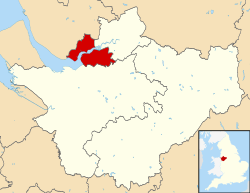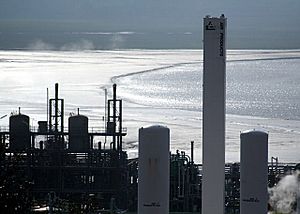Borough of Halton facts for kids
Quick facts for kids
Halton
|
|
|---|---|
|
Borough and Unitary authority
|
|

The Silver Jubilee Bridge at dusk
|
|
| Motto(s):
Latin: Industria Navem Implet
("Industry fills the ship") |
|

Halton shown within Cheshire
|
|
| Sovereign state | |
| Constituent country | |
| Region | North West England |
| City region | Liverpool |
| Ceremonial county | |
| Settled | 10th century |
| Incorporated | 1974 (borough) |
| 1998 (Unitary authority) | |
| Town Hall | Runcorn |
| Administrative HQ | Widnes |
| Government | |
| • Type | Unitary authority |
| • Body | Halton Borough Council |
| Area | |
| • Borough | 30.54 sq mi (79.09 km2) |
| Area rank | 242nd |
| Population
(2005 est.)
|
|
| • Borough | 129,410 |
| • Rank | 178th |
| Time zone | UTC+0 (Greenwich Mean Time) |
| • Summer (DST) | UTC+1 (British Summer Time) |
| Postcode area |
WA4, WA7, WA8, L24
|
| Dialling code | 0151 Widnes and Hale Village, 01928 Runcorn, 01925 Daresbury |
| ISO 3166 code | GB-HAL |
| GSS code | E06000006 |
| NUTS 3 code | UKD71 |
| ONS code | 00ET |
| Motorways | M56 |
| Major railway stations | Runcorn (C1) |
| MPs | Derek Twigg (L) Mike Amesbury (L) |
| Police area | Cheshire |
| Fire service | Cheshire |
| Ambulance service | North West |
| Website | www.halton.gov.uk |
Halton (pronounced HOL-tən) is a unitary authority district with borough status in Cheshire, North West England. It was created in 1974 as a district of the non-metropolitan county of Cheshire, and became a unitary authority area on 1 April 1998 under Halton Borough Council. Since 2014 it has been a member of the Liverpool City Region Combined Authority. The borough consists of the towns of Runcorn and Widnes and the civil parishes of Daresbury, Hale, Halebank, Moore, Preston Brook, and Sandymoor. The district borders Merseyside, Warrington and Cheshire West and Chester.
History
Although Halton town dates back to the 12th century (and beyond) when land on both sides of the river belonged to the Barony of Halton, the origin of the District Council was the outcome of the local government commission's suggested reforms of England, in 1969, the Redcliffe-Maud Report. This proposed to create metropolitan counties constituted of metropolitan district councils in the most urbanised parts of England. The model was that of the London Boroughs and Greater London Council formed in 1965. Southern Lancashire and northern Cheshire were among these urban areas, and two new metropolitan Counties were to be formed around Liverpool (as Merseyside) and Manchester (as Greater Manchester). However, the towns of Widnes and Runcorn (and the County Borough of Warrington) which lay between these were reluctant to join either. The Commission agreed that Halton and Warrington would become districts within Cheshire, as they would be detached from Lancashire by the two new metropolitan counties controlling the territory to the north.
The district was formally established on 1 April 1974 from Runcorn urban district and part of Runcorn Rural District from Cheshire, and the borough of Widnes and the parish of Hale from the Whiston Rural District in Lancashire. On 1 April 1998 Halton became an independent unitary authority, though it is still served by Cheshire Police and Cheshire Fire and Rescue Service, and forms part of Cheshire for ceremonial purposes, such as the Lord Lieutenancy.
On 1 April 2014 Halton became part of the Liverpool City Region Combined Authority, joining the local authorities of Liverpool, Sefton, Wirral, Knowsley and St Helens, the five metropolitan district councils which constitute the county of Merseyside. This effectively reverses the position adopted in the 1970s which created it as an anomaly. As a unitary authority its status is similar to the metropolitan district councils.
Demographics
Population growth
The population of Halton is 129,410 (2020). The change in population during the 20th century is shown in the following table.
| Year | Population | Change as % |
|---|---|---|
| 1901 | 57,755 | — |
| 1911 | 57,062 | -1.2% |
| 1921 | 61,039 | +7.0% |
| 1931 | 65,309 | +7.0% |
| 1941 | 71,835 | +10.0% |
| 1951 | 79,026 | +10.0% |
| 1961 | 87,168 | +10.3% |
| 1971 | 96,150 | +10.3% |
| 1981 | 121,861 | +26.7% |
| 1991 | 124,915 | +2.5% |
| 2001 | 118,215 | -5.4% |
| 2011 | 125,700 | +6.3% |
Religion
In the 2011 census, Christianity was the main religion in Halton at 75%, well above the national average for England of 59.4%. 18.7% stated that they had "no religion". Those stating their religions as Buddhist, Hindu, Jewish, Islam or Sikh amounted to 0.8%.
Ethnicity
In the 2011 census, 97.8% of Halton residents identified as White and 2% were Non-White. From the 2011 School Census, the main first language apart from English was Polish.
Economy
Halton is an industrial and logistics hub with a higher proportion of people working in manufacturing (particularly chemicals and advanced manufacturing), wholesale and retail, and transport and storage compared to the average for England.
| Industry | Halton (Employee Jobs) | Halton (%) | North West (%) | Great Britain (%) | Halton - Great Britain Difference |
|---|---|---|---|---|---|
| H Transportation And Storage | 7,000 | 10.8 | 5.6 | 4.9 | 5.9 |
| C Manufacturing | 8,000 | 12.3 | 9.3 | 8.0 | 4.3 |
| G Wholesale And Retail Trade; Repair of Motor Vehicles And Motorcycles | 11,000 | 16.9 | 16.3 | 15.0 | 1.9 |
| N Administrative And Support Service Activities | 7,000 | 10.8 | 8.6 | 8.9 | 1.9 |
| Q Human Health And Social Work Activities | 9,000 | 13.8 | 14.2 | 13.1 | 0.7 |
| E Water Supply; Sewerage, Waste Management And Remediation Activities | 800 | 1.2 | 0.7 | 0.7 | 0.5 |
| M Professional, Scientific And Technical Activities | 6,000 | 9.2 | 8.8 | 8.8 | 0.4 |
| S Other Service Activities | 1,500 | 2.3 | 1.9 | 2.0 | 0.3 |
| B Mining And Quarrying | 300 | 0.5 | 0.1 | 0.2 | 0.3 |
| F Construction | 3,000 | 4.6 | 4.6 | 4.9 | -0.3 |
| D Electricity, Gas, Steam And Air Conditioning Supply | 75 | 0.1 | 0.5 | 0.4 | -0.3 |
| L Real Estate Activities | 600 | 0.9 | 1.5 | 1.7 | -0.8 |
| R Arts, Entertainment And Recreation | 1,000 | 1.5 | 2.6 | 2.5 | -1.0 |
| O Public Administration And Defence; Compulsory Social Security | 2,000 | 3.1 | 4.6 | 4.4 | -1.3 |
| J Information And Communication | 1,500 | 2.3 | 2.8 | 4.3 | -2.0 |
| K Financial And Insurance Activities | 600 | 0.9 | 2.8 | 3.5 | -2.6 |
| I Accommodation And Food Service Activities | 3,000 | 4.6 | 6.9 | 7.7 | -3.1 |
| P Education | 3,500 | 5.4 | 8.0 | 8.7 | -3.3 |
The wages of employees in Halton are slightly higher than the average for England and significantly higher than the average for the North West and the Liverpool City Region. Business survival rates are also significantly higher than both the regional and national averages. In 2018, the GVA per head of population in Halton was £26,988 compared to a regional average of £22,244 in North West England.
Images for kids
-
Halton Castle overlooking the Mersey Gateway Bridge






